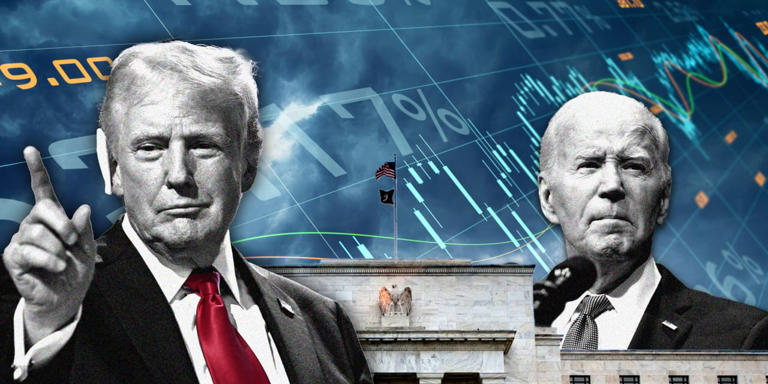Historically, U.S. presidential election years have been favorable for the stock market. The heightened attention to developments in the race between incumbent President Joe Biden and Republican challenger Donald Trump is largely due to the significant market implications of their policies and the potential for market stability or volatility. Investors are particularly attuned to this year’s election dynamics, as they may have substantial effects on various sectors and the overall market sentiment.
Impact of the “Trump Trade”
The “Trump trade” has emerged as a critical element in the current market scenario, especially following an assassination attempt on Trump that he survived. This incident has seemingly bolstered confidence in his candidacy, influencing market sentiment toward a more favorable outlook for Trump’s prospects. Investors are speculating that a clear election outcome, potentially a Republican sweep of Congress, could reduce market uncertainties significantly. This optimism is especially pronounced in sectors that might benefit from Trump’s policies, such as deregulation and tax cuts.
However, it is essential to note that this optimism is not uniformly distributed across all sectors. Some analysts caution that the rationale behind certain stock movements may not be entirely sound, indicating that the market’s response could be more speculative than based on solid fundamentals.
Influence of Inflation and Federal Reserve Policy
The June consumer-price index showed lower inflation, which has bolstered market expectations that the Federal Reserve will initiate a long-anticipated monetary easing cycle. This projection includes a quarter percentage point interest rate cut in September. The CME FedWatch Tool indicates a roughly 98% probability of at least a 25 basis point rate cut by the September Federal Open Market Committee (FOMC) meeting. This expectation has provided a significant boost to market sentiment, as lower interest rates are generally favorable for stock prices.
Market Rotation
The interplay between election developments and anticipated rate cuts has sparked a notable market rotation. Ed Clissold and Thanh Nguyen of Ned Davis Research highlighted a shift from megacap tech stocks to small-caps and value stocks. This rotation saw the small-cap Russell 2000 index achieve an 11.5% return over five days, although it subsequently gave back some gains. This shift is seen as a necessary correction after a prolonged period where market gains were concentrated in a few AI-driven megacap technology stocks.
Market Breadth Improvement
The recent rally had been notably narrow, concentrated in a handful of artificial intelligence (AI) megacap technology stocks. However, recent improvements in market breadth indicate more widespread participation in the rally, a positive sign for the market’s overall health. Despite the Russell 2000’s impressive gains, the gap between it and the S&P 500 remains significant, with the S&P 500 up over 15% in 2024 compared to the Russell’s 7.8% increase.
Small-Cap Performance
Liz Young Thomas, head of investment strategy at SoFi, noted that the recent surge in the small-cap index achieved gains in a short period that many had hoped for over the past two and a half years. She highlighted that while large-cap outperformance made sense due to tech-driven earnings, stretched valuations for large-caps and expected improvements in small-cap earnings could set a favorable backdrop for small-caps moving forward.
Interest rate cuts also favor small-caps, which are more sensitive to rates due to their higher leverage and reliance on floating rate debt. Lower rates can significantly impact small-cap sentiment positively, as these companies benefit more from reduced borrowing costs.
Election Uncertainty and Market Reactions
The chaotic nature of the 2024 election cycle further complicates market dynamics. President Biden’s weak debate performance and the subsequent pressure from fellow Democrats for him to step aside have added to the uncertainty. Conversely, Trump’s survival of an assassination attempt and his ongoing legal challenges have created a volatile political environment.
Larry Adam, chief investment officer at Raymond James, pointed out that Trump’s probability of victory has reached a “cyclical high” of 70% based on betting markets. The potential for a new round of aggressive deregulation under a Trump administration could benefit sectors like energy, financials, and healthcare. However, the unpredictability of the election cycle means that anything could happen in the remaining months, further adding to market volatility.
Fiscal Policies and Market Implications
Both Biden and Trump are not seen as prioritizing deficit reduction. Trump’s fiscal plans, including extending the 2017 tax cuts and reducing corporate tax rates, could exacerbate the fiscal deficit, leading to higher Treasury yields. His proposed import tariffs might also introduce inflationary pressures, complicating the Federal Reserve’s interest rate policies.
These fiscal policies have significant market implications. For instance, Trump’s tariff proposals are seen as potentially inflationary, raising questions about how far the Federal Reserve will be able to cut interest rates once it begins an easing cycle and how far Treasury yields might fall. The market’s response to these proposals will need to be closely monitored if Trump is elected.
Short-Term Market Movements
Recent market wobbles have seen the S&P 500 and Russell 2000 retrace some gains. Despite this, Kevin Dempter of Renaissance Macro Research suggests that the broader rally setup remains bullish for the next 3-6 months. The improved market breadth and momentum signals are seen as positive indicators for the market’s direction. As overbought conditions ease, the bullish trend is expected to resume, driven by a more inclusive market rally and the positive impacts of anticipated rate cuts.
In conclusion, the 2024 U.S. presidential election and associated market dynamics present a complex but potentially favorable backdrop for investors. The interplay of election outcomes, Federal Reserve policies, and market rotations will continue to shape market sentiment and performance in the coming months.
